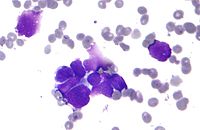
Photo from wikipedia
Importance Traditionally, liver transplant (LT) for alcohol-associated liver disease (ALD) requires 6 months of abstinence. Although early LT before 6 months of abstinence has been associated with decreased mortality for… Click to show full abstract
Importance Traditionally, liver transplant (LT) for alcohol-associated liver disease (ALD) requires 6 months of abstinence. Although early LT before 6 months of abstinence has been associated with decreased mortality for decompensated ALD, this practice remains controversial and concentrated at a few centers. Objective To define patient, allograft, and relapse-free survival in early LT for ALD, and to investigate the association between these survival outcomes and early vs standard LT. Design, Setting, and Participants This cohort study analyzed all patients with ALD who underwent their first LT at a single academic referral center between October 1, 2012, and November 13, 2020. Patients with known pretransplant hepatocellular carcinoma, hepatitis B or C, or an alternative cause of liver failure were excluded. Follow-up period was defined as the time from LT to the most recent encounter with a transplant center or death. Exposures The exposure of interest was early LT, which was defined as less than 180 days of pre-LT abstinence. Standard LT was defined as 180 days or more of pre-LT abstinence. Patients were separated into early LT and standard LT by time from abstinence to LT. Main Outcomes and Measures The outcomes were patient, allograft, relapse-free, and hazardous relapse-free survival for patients who underwent early LT or standard LT. These groups were compared by log-rank testing of Kaplan-Meier estimates. Hazardous relapse was defined as binge, at-risk, or frequent drinking. Abstinence was reassessed at the most recent follow-up visit for all patients. Results Of the 163 patients with ALD included in this study, 88 (54%) underwent early LT and 75 (46%) underwent standard LT. This cohort had a mean (SD) age at transplant of 52 (10) years and was predominantly composed of 108 male patients (66%). Recipients of early LT vs standard LT were younger (median [interquartile range (IQR)] age, 49.7 [39.0-54.2] years vs 54.6 [48.7-60.0] years; P < .001) and had a higher median (IQR) Model for End-stage Liver Disease score at listing (35.0 [29.0-39.0] vs 20.0 [13.0-26.0]; P < .001). Both recipients of early LT and standard LT had similar 1-year patient survival (94.1% [95% CI, 86.3%-97.5%] vs 95.9% [95% CI, 87.8%-98.7%]; P = .60), allograft survival (92.7% [95% CI, 84.4%-96.7%] vs 90.5% [95% CI, 81.0%-95.3%]; P = .42), relapse-free survival (80.4% [95% CI, 69.1%-88.0%] vs 83.5% [95% CI, 72.2%-90.6%]; P = .41), and hazardous relapse-free survival (85.8% [95% CI, 75.1%-92.2%] vs 89.6% [95% CI, 79.5%-94.9%]; P = .41). Conclusions and Relevance Adherence to the 6-month rule was not associated with superior patient survival, allograft survival, or relapse-free survival among selected patients. This finding suggests that patients with ALD should not be categorically excluded from LT solely on the basis of 6 months of abstinence, but rather alternative selection criteria should be identified that are based on need and posttransplant outcomes.
Journal Title: JAMA surgery
Year Published: 2021
Link to full text (if available)
Share on Social Media: Sign Up to like & get
recommendations!